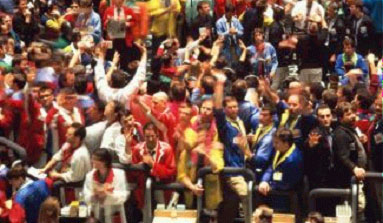The world's stock markets have an interesting history. This article outlines the origins of the modern day markets, and discusses the differences between how each market works. Knowing how the markets function is important information for anyone who chooses to invest.
The first publicly issued security can be tracked back to the fourteenth century in Venice. The governing body of Venice wished to begin paying back debt to neighboring countries that had been incurred in recent times. After discovering that they were unable to do so, the government made the first known issue of bonds. These government securities were purchased by merchants and landowners as investments. Bonds are still issued today by governments primarily to service debt and also to encourage cash based investment.
In London in 1693 King William of England raised one million pounds from the public at a fixed interest rate of 10%. A year later the Bank of England was formed so that the government could finance wars. Credit facilities were set up to encourage merchants to expand their business, and systems were put in place to enable merchants to raise public funds through the issue of an early type of share.
The largest public company at that time was the South Seas Company which was listed In 1711. Robert Harley took over the government debt of 9 million pounds in exchange for exclusive rights to trade with Spain in the South Seas.
Following the exponential growth of the South Seas Company, a number of the company's Directors decided to sell a large number of shares. This caused the share's price to tumble, and also began what could be described as the first stock market crash.
Traders in these early companies would commonly meet in Jonathans CoffeeHouse to trade shares and make business deals. Early share bids and offers were written on the CoffeeHouse walls and the trading process was highly unregulated, with insider trading forming the basis for most investment decisions.
By 1773, Trading Clubs had formed, and in 1801 a group of traders raised 20,000 pounds to build the London Stock Exchange in Capel Court.
A similar process was occurring in America. By the early 1790s many merchants had begun trading shares. Just as in London, these early traders often met at coffeehouses in an informal environment.
In 1792, 24 Brokers who each paid $400 for a "trading seat" signed the Buttonwood Tree Agreement. This agreement outlined the regulations under which shares could be bought and sold. These regulations formed the basis for trading rules that still exist today and led to the formation in 1817 of the New York Stock Exchange.
New York quickly became, and continues to be the largest financial center in the world. Interestingly however, the New York Stock Exchange (NYSE) is not the most modern or efficient.
All early stock exchanges used trading systems that were based upon an "open outcry" method of buying and selling. Open outcry trading occurs between people who wish to buy or sell shares. Each trader openly negotiates with each other to gain the best price for the shares they wish to buy or sell. This results in an extremely chaotic atmosphere that you will remember from movies like Wall Street and various news articles. The picture below shows the trading floor of the Chicago Board of Trade (CBOT) where Futures contracts are traded. The CBOT is the largest open outcry exchange in the world.
 As technology developed, most stock exchanges began to use computers to replace floor traders. The NYSE is one of the only stock exchanges in the world that still functions on an open-outcry trading system. Floor traders take phone and computer orders from brokers, and negotiate a trade with stock specialists at trading stations on the trading floor. The NYSE is currently implementing a completely automated computer system, until then the NYSE will remain an exciting and stressful place.
As technology developed, most stock exchanges began to use computers to replace floor traders. The NYSE is one of the only stock exchanges in the world that still functions on an open-outcry trading system. Floor traders take phone and computer orders from brokers, and negotiate a trade with stock specialists at trading stations on the trading floor. The NYSE is currently implementing a completely automated computer system, until then the NYSE will remain an exciting and stressful place.
Computer systems have allowed market access for many more individual investors. In New Zealand and Australia the exchanges are completely automated. The orders you place with your broker are placed into the stock exchange computer via a computer trading system that is usually unique to each exchange.
There is a common misconception that trading through the Internet means that you are placing your orders directly into the stock exchange. Unfortunately this is not the case. In New Zealand and Australia, your order must first be processed and authorised through your stockbrokers computer system.
This results in a slight delay from when you hit the "buy" key, to when you actually get your order filled in the exchange computer system. This delay can be frustrating for you as an individual but is a fraction of the time that an order used to take, under an open-outcry system.
As technology and security systems improve, individuals will be able to trade directly between each other via open computer systems. This will result in fast and accurate trading, but will certainly increase the speed and volatility of the already busy modern exchanges.
Next weeks article will focus on the local markets and will discuss the different systems and considerations of the New Zealand and Australian markets.
This article was written by Nick McCaw from Intelligent Investing